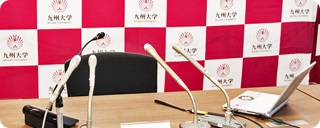研究成果 Research Results
- TOP
- News
- Research Results
- How old is that microplastic? A new way to estimate the age of microplastics in the upper ocean
How old is that microplastic? A new way to estimate the age of microplastics in the upper ocean
Researchers develop a method to estimate the age of microplastics in the ocean, and find that offshore microplastics can range from 1 to 3 years old while nearshore microplastics can range from 0 to 5 years old 2023.05.15Research ResultsMath & DataMaterialsEnvironment & Sustainability
Fukuoka, Japan—Researchers from Kyushu University and Asahi Kasei Corporation have developed a new way to estimate the age of microplastics found in the upper oceans. The method involves a combination of analyzing plastic oxidation levels with environmental factors such as UV exposure and ambient temperature.
The team applied their new method to estimate the age of microplastics found in nearshore and offshore sites in the North Pacific Ocean. They found that the age of microplastics in nearshore regions ranged from 0 to 5 years old, whereas microplastics from offshore regions ranged from 1 to 3 years old. Their findings were published in the journal, Marine Pollution Bulletin.
In marine environments from lakes to oceans, plastics are the most abundant type of pollutant. As plastic waste is exposed to the elements they eventually break down and fragment. Plastic waste that has broken down to less than 5 mm in length are called 'microplastics.'
"Microplastic pollution is recognized as a global problem. In a previous study, we found that there are about 24 trillion grains of microplastics floating on the surface layer of the ocean," explains Professor Atsuhiko Isobe of Kyushu University's Research Institute for Applied Mechanics, who led the study. "However, there is still little we know about its effects on the environment or to living creatures. Another big question we have is how long microplastics drift through the ocean."
To find out how old microplastics found in the ocean can be, Isobe and his team began by investigating what metrics could be used to measure microplastic age in the first place.
"The most common material in plastic is called polyethylene. We know that as polyethylene interacts with the environment it, oxidizes and degrades," explains Rie Okubo, a researcher at Asahi Kasei Corporation and first author of the study. "This degradation level can be measured using the change in the material's molecular weight and something called the carbonyl index. Simply, when polyethylene degrades its carbonyl index increases and molecular weight decreases."
Of course, that's not enough. Since microplastics are being exposed to the elements the team also needed to standardize how temperature and UV radiation affects plastic degradation. The team first conducted a series of exposure experiments to polyethylene material and collected data on how various combinations of UV and temperature affected the material's molecular weight and carbonyl index.
The team found that UVER—ultraviolet erythemal radiation, a measurement of UV radiation at ground level—and seawater temperature were the two biggest contributors of plastic degradation.
"Once we had this data, we began to apply it to our microplastic samples. All our samples came from the upper ocean, up to one meter from the water surface," continues Okubo. "We also collected microplastics from a range of areas. Some samples were collected nearshore to Japan, ranging from 10 to 80 km off the coast. Other samples were collected offshore, in the middle of the North Pacific Ocean and Philippine Sea."
By analyzing the collected microplastics, the team was able to estimate the age of each induvial sample. They found that nearshore microplastics ranged from 0 to 5 years old, whereas offshore samples ranged from 1 to 3 years old.
"We hypothesize the reason why nearshore microplastics range from 0 to 5 years is because they are being frequently washed ashore and 'surviving' for a longer time. Offshore microplastics on the other hand take longer to reach that part of the ocean, hence why we didn't find microplastics over 3 years old," Okubo explains. "These offshore microplastics are also likely removed from the upper oceans by settling deeper into the waters."
The researchers hope that the new method will give them better insights into how microplastics are generated and spread in the environment. The data will also help in developing more accurate simulations to track microplastics across the ocean.
Isobe concludes, "Our research and understanding of microplastics is still very new, and thanks to this data we've gained a little more understanding on the fundamental science of microplastics. Our next step will be to investigate how mechanical stimuli like ocean waves and currents can degrade plastics, so we can collect even more accurate data.
###
For more information about this research, see "Estimation of the age of polyethylene microplastics collected from oceans: Application to the western North Pacific Ocean," Rie Okubo, Aguru Yamamoto, Akihiro Kurima, Terumi Sakabe, Youichiroh Ide, Atsuhiko Isobe Marine Pollution Bulletin, https://doi.org/10.1016/j.marpolbul.2023.114951
About Kyushu University
Kyushu University is one of Japan's leading research-oriented institutes of higher education since its founding in 1911. Home to around 19,000 students and 8,000 faculty and staff, Kyushu U's world-class research centers cover a wide range of study areas and research fields, from the humanities and arts to engineering and medical sciences. Its multiple campuses—including one of the largest in Japan—are located around Fukuoka City, a coastal metropolis on the southwestern Japanese island of Kyushu that is frequently ranked among the world's most livable cities and historically known as Japan's gateway to Asia. Through its Vision 2030, Kyushu U will 'Drive Social Change with Integrative Knowledge.' Its synergistic application of knowledge will encompass all of academia and solve issues in society while innovating new systems for a better future.
About Asahi Kasei
The Asahi Kasei Group contributes to life and living for people around the world. Since its foundation in 1922 with ammonia and cellulose fiber business, Asahi Kasei has consistently grown through the proactive transformation of its business portfolio to meet the evolving needs of every age. With more than 46,000 employees worldwide, the company contributes to sustainable society by providing solutions to the world’s challenges through its three business sectors of Material, Homes, and Health Care. For more information, visit www.asahi-kasei.com.
Asahi Kasei is also dedicated to sustainability initiatives and is contributing to reaching a carbon neutral society by 2050.
To learn more, visit https://www.asahi-kasei.com/sustainability/.
Samples of microplastics. Microplastic samples collected from the oceans. Plastic fragments less than 5 mm in length are categorized as microplastics. The scale bar shows a length of 2000 µm or 2 mm. (Kyushu University/Asahi Kasei Corporation)
Microplastic sampling. Dr Okubo looking through a microscope studying microplastic samples. Plastic fragments less than 5 mm in length are categorized as microplastics. (Kyushu University/Asahi Kasei Corporation)
Collecting Microplastics. Prof Atsuhiko Isobe and crew collecting microplastic samples from the upper oceans. The upper ocean is measured down to one meter from the water surface. (Kyushu University/Isobe Lab)
Gathering Microplastics. Prof Atsuhiko Isobe and gathering the microplastic samples collected from the upper ocean. (Kyushu University/Isobe Lab)
[Contact]
Research-related inquiries
Atsuhiko Isobe, Professor
Research Institute for Applied Mechanics
Center for Oceanic and Atmospheric Research
Contact information can also be found in the full release.
- TOP
- News
- Research Results
- How old is that microplastic? A new way to estimate the age of microplastics in the upper ocean































